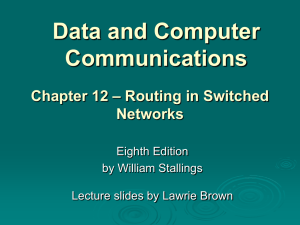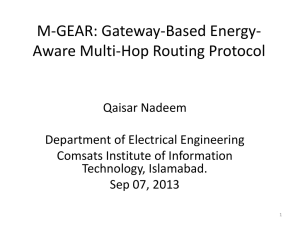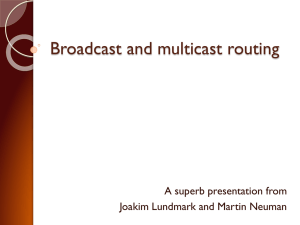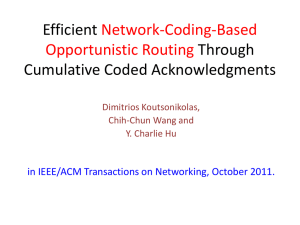Data Communications and Networking
advertisement
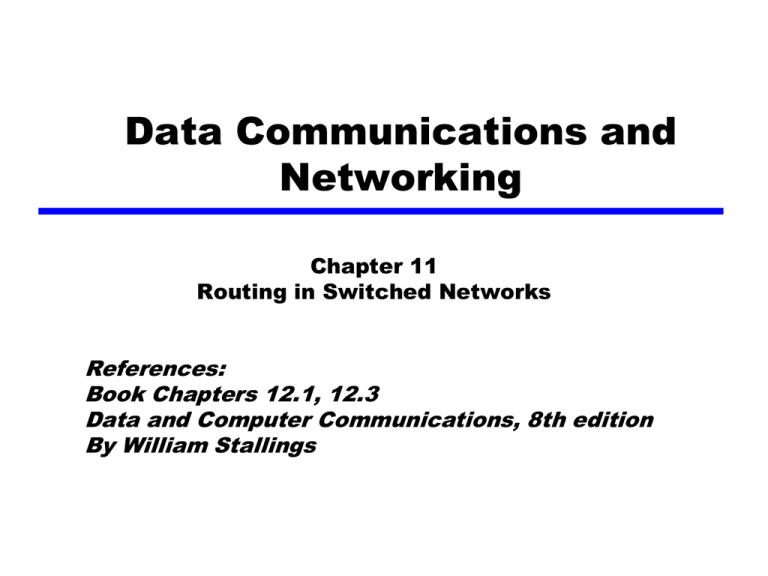
Data Communications and
Networking
Chapter 11
Routing in Switched Networks
References:
Book Chapters 12.1, 12.3
Data and Computer Communications, 8th edition
By William Stallings
Routing in Packet-Switching
Network
•
Recall the function of a packet-switching network
•
To accomplish this, a path or route through the network must be
determined.
In general terms, routing seeks to design routes through the network for
individual pairs of communicating end nodes such that the network is used
efficiently.
•
•
— To accept packets from a source station and deliver them to a destination
station.
— Routing is one of the most complex and crucial design aspects of switched data
networks.
Required characteristics of routing function:
— Correctness
— Simplicity
— Robustness: the ability to deliver packets via some route in the face of localized
failures and overloads
— Stability
— Fairness
— Optimality
— Efficiency: routing involves processing overhead & transmission overhead
2
Performance Criteria
• The selection of a route is generally based on
some performance criterion.
• The simplest criterion:
—Minimum-hop (the least number of nodes)
• A generalization of minimum-hop criterion:
—Least-cost routing: a cost is associated with each link
• E.g., in minimum-hop, each link has a cost of 1
• The route that accumulates the least cost is sought.
3
Example Network Configuration
Least-cost path
from node 1 to 6
4
Decision Time and Place
• Two characteristics of routing decision:
— Time and place that the decision is made
• Decision time
— Datagram: a routing decision is made individually for each packet
— Virtual circuit: a routing decision is made at the time the virtual circuit
is established
• Decision place: which node or nodes are responsible for the routing
decision?
— Distributed routing
• Each node has the responsibility of selecting an output link for routing
packets as they arrive
— Centralized routing
• Decision is made by some designated node
— Source routing
• Decision is made by the source station
5
Network Information Source
and Update Timing
• Routing decisions usually are based on knowledge of
network (not always): topology, traffic load, link cost
• Distributed routing
— Nodes use local knowledge
— May collect info from adjacent (directly connected) nodes
— May collect info from all nodes on any potential route of interest
• Centralized routing
— Collect info from all nodes
• Timing for node information update
— Fixed strategy – the info is never updated
— Adaptive strategy – the info is regularly updated
6
Routing Strategies
• Many routing strategies have evolved in packetswitching networks. Four of them will be
introduced here:
—Fixed routing
—Flooding
—Random routing
—Adaptive routing
7
Fixed Routing
• A single, permanent route is configured for each
source-destination (s-d) pair of nodes in the
network.
—Determine routes using any least-cost algorithm
—The link costs could be based on expected traffic or
capacity.
• Routes are fixed, or at least only change when
there is a change in network topology.
• A central routing directory (table) is created,
which shows for each s-d pair of nodes, the
identity of the next node on the route.
8
Fixed Routing
Tables
Using the figure on
Slide 4.
It is not necessary to
store the complete
central routing
directory for each
pair of nodes.
9
Flooding
• Flooding requires no network info.
• A packet is sent by a source node to every neighbor.
• At each node, an incoming packet is forwarded to all outgoing links
except the incoming link.
• Eventually a number of copies will arrive at destination.
• Each packet is uniquely numbered so duplicates can be discarded.
• Nodes can remember the identity of those packets it has already
retransmitted.
• Another technique: include a hop count field with each packet. Each
time a node passes on a packet, it decrements the hop count by
one. When the count reaches zero, the packet is discarded.
— The hop count is sometimes called “time-to-live” (TTL)
— Recall that TTL is also used in IP header which has nothing to do with
flooding!
10
Flooding Example
The TTL value decreases by
one after each hop.
11
Properties of Flooding
• All possible routes are tried
—A packet will always get through if at least one path
between source and destination exists.
• At least one copy of the packet will have taken
the minimum-hop-count route
—Can be used to set up the virtual circuit
• All nodes that are directly or indirectly
connected to the source node are visited.
—Useful to broadcast information (e.g. routing
information)
• Disadvantage: high traffic load
12
Random Routing
• Random routing has the simplicity and
robustness of flooding, with far less traffic load.
• A node selects only one outgoing path to
forward the incoming packet
—The outgoing link can be selected at random,
excluding the link on which the packet arrived.
• A refinement is to select outgoing path based on
probability calculation
• Like flooding, no network info needed
• Disadvantage: route is typically not least-cost
nor minimum-hop
13
Adaptive Routing
• Routing decisions change as conditions on the network
change
— Failure: node or link fails
— Congestion: a portion of the network is heavily congested
• Requires info about the state of the network
• Drawbacks, compared to fixed routing
— Routing decision is more complex; the processing burden on
nodes increases
— A tradeoff between quality of network info and the cost of
updating such info
• Advantages
— Improved performance
— Can aid in congestion control, because an adaptive routing
strategy tends to balance loads.
14
Least Cost Algorithms
• Virtually all packet-switching networks base their routing
decisions on some form of lest-cost criterion.
— Can minimize hop with each link cost 1
— Can have link value inversely proportional to capacity
• Least-cost routing problem
— Given a network of nodes connected by bi-directional links,
where each link has a cost associated with it in each direction,
define the cost of a path between two nodes as the sum of
costs of links traversed. For each pair of nodes, find a path with
the least cost.
• Two common algorithms
— Dijkstra’s algorithm
— Bellman-Ford algorithm
15
Dijkstra’s Algorithm Definitions
• Find the shortest paths from a single source node to all other
nodes, by developing paths in order of increasing path length
• N = set of nodes in the network
• s = source node
• T = set of nodes so far incorporated by the algorithm (its leastcost path to s is finalized)
• w(i, j) =link cost from node i to node j
— w(i, i) = 0
— w(i, j) = if the two nodes are not directly connected
— w(i, j) 0 if the two nodes are directly connected
• L(n) = cost of the least-cost path from node s to node n that is
currently known to the algorithm
— At termination, L(n) is cost of the least-cost path from s to n
— Initially, all L(n) are
16
Dijkstra’s Algorithm Method
• Step 1 [Initialization]
— T = {s}: the set of nodes so far incorporated consists of only
the source node
— L(n) = w(s, n) for n ≠ s: the initial path costs to neighboring
nodes are simply the link costs
• Step 2 [Get Next Node]
— Find the neighboring node not in T with the least-cost path from
s (smallest L(n) )
— Incorporate that node into T
— Also incorporate the edge that is incident on that node and a
node in T that contributes to the path
• Step 3 [Update Least-Cost Paths]
— L(n) = min[L(n), L(x) + w(x, n)] for all n T
— If the latter term is smaller, the path from s to n is now updated
as the path from s to x extended with the edge from x to n
17
Dijkstra’s Algorithm Notes
• Terminate when all nodes have been added to T
• At termination, value L(n) associated with each
node n is the cost of least-cost path from s to n.
• In addition, algorithm defines the least-cost
path from s to each other node
• One iteration of steps 2 and 3 adds one new
node to T, and defines the least-cost path from
s to that node
18
Example of Dijkstra’s Algorithm
19
Example of Dijkstra’s
Algorithm
S=1
20
Bellman-Ford Algorithm
Definitions
• Find the least-cost paths from a given source node
subject to constraint that the paths contain at most one
link, then find the shortest paths with a constraint of
paths of at most two links, and so on.
• Finally, this algorithm returns the least-cost paths
between any pairs of nodes.
• s = source node
• w(i, j) = link cost from node i to node j
— w(i, i) = 0
— w(i, j) = if the two nodes are not directly connected
— w(i, j) 0 if the two nodes are directly connected
• h = maximum number of links in a path at the current
stage of the algorithm
• Lh(n) = cost of the least-cost path from s to n under the
constraint of no more than h links
21
Bellman-Ford Algorithm Method
• Step 1 [Initialization]
—L0(n) = , for all n s
—Lh(s) = 0, for all h
• Step 2 [Update]
—For each successive h 0
• For each n ≠ s, compute
Lh+1(n)=min{ Lh(n), minj[Lh(j)+w(j,n)] }
• It means “the least-cost path from s to n of length h+1 is
the least-cost path of length h, or it is actually a length h+1
path, and before it reaches n, it passes through j”
22
Example of Bellman-Ford
Algorithm
23
Example of Bellman-Ford
Algorithm
S=1
24
Comparison
• What information needs to be gathered?
• Bellman-ford
—Each node can maintain a set of costs and associated
paths for every other node and exchange this
information with its direct neighbors from time to
time
—Each node can update its costs and paths using only
the information from its neighbors and knowledge of
its link costs.
• Dijkstra’s algorithm
—Each node must have complete topological
information about the network
25
